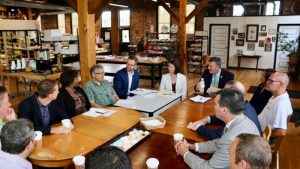
U.S. Reps. Darin LaHood (R-IL) and Mike Kelly (R-PA) on May 17 introduced the Historic Tax Credit Growth and Opportunity Act to update the federal Historic Tax Credit (HTC), which encourages private investment in historic building preservation around the United States.
“Strengthening this tax credit will expand economic development in Illinois and allow for more historic preservation projects to move forward,” Rep. LaHood said earlier this week. “I am proud to join this bipartisan group in this commonsense effort to expand historic preservation across the country.”
Among those joining Reps. Kelly and LaHood in introducing H.R. 2825 were bill sponsor U.S. Rep. Earl Blumenauer (D-OR) and cosponsor U.S. Rep. Mike Turner (R-OH).
If enacted, H.R. 2825 would update the HTC for the first time in three decades to improve the credit for smaller deals in which qualified rehabilitation expenses are not more than $3.75 million by increasing the credit to 30 percent from 20 percent, according to the lawmakers.
“This bill modernizes the credit to ensure it is more available to the communities who need it most,” said Rep. Kelly on Monday.
H.R. 2825 also would make more buildings eligible for the HTC and would eliminate the credit’s basis adjustment, the congressmen said.
“In central and west-central Illinois, we have a rich and unique history that includes many historic buildings and landmarks,” Rep. LaHood said. “The Historic Tax Credit has played a critical role in preserving heritage in the State of Illinois and spurring economic growth in our rural communities.”
Rep. Kelly added that in western Pennsylvania, numerous cities and towns “benefit greatly” from the HTC. “Monuments to our past keep us connected to those who came before us and investing in them bolsters our economy by creating jobs,” he said.
Thus far, the HTC has attracted $131 billion in private capital, created over 2.4 million jobs and rehabilitated more than 43,000 buildings, according to a statement from Rep. LaHood’s office, which added that some 40 percent of the projects completed over the last 15 years are located in communities with populations of less than 25,000.



